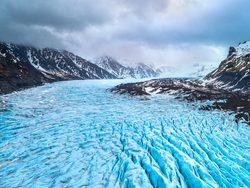
Quick Navigation
Vatnajokull National Park is located in the eastern thru southeastern part of Iceland. It covers an area of 5,459.9 square miles (14,141 sq km) accounting for about 14% of the country and serving as Europe’s second-largest national park.
It is home to Vatnajokull, which outside of the Arctic, is the largest glacier in Europe covering an area of 3,127 square miles (8,100 sq km). Hvannadalshnukur is the highest mountain summit in Iceland with a height of 6,921 feet (2,109.6 m).
Vatnajokull National park is a special place with landscapes that are hard to find rivals and provide visitors with unique experiences from geothermal features that interact with rivers, glaciers, mountains, and volcanic activity. Some of these features like the massive canyons and glacial rivers leave people more impressed than the ice cap itself.
The majority of wildlife is arctic marine, however, collectively it is quite sparse. Seals are one of the most prevalent and you have a decent chance of seeing them. Seagulls and other birds are also soaring around. But again, Vatnajokull National Park is not known for wildlife, but rather tons of blue ice.
The park is divided into four regions: Norther Territory, Eastern Territory, Southern Territory, and Western Territory with each having its own unique facets of nature to experience.
- Northern Territory: features the Jokulsarljufur canyon, Askja caldera, and the north-wester part of the Vatnajokull glacier.
- Eastern Territory: features the Kverkfjoll mountains and the north-eastern part of the Vatnajökull glacier.
- Southern Territory: features the wilderness area of Lonsoraefi, Lomagnupur mountain, and the south-eastern part of the Vatnjökull glacier.
- Western Territory: features the Lakagigar craters and the south-western part of Vatnajökull.
Highlights
Vatnajökull National Park is a national park that provides visitors with an awe-inspiring experience where rivers, mountains, glaciers, ice caves, volcanic, and geothermal features collide together into one of the most amazing experiences with nature.
Each of the different regions of the park offers a variety of experiences and worthy of exploration.
 Vatnajökull Glacier
Vatnajökull Glacier
Vatnajökull Glacier is renowned around the world. It the Europe's second most voluminous ice cap and the largest in Iceland. It is probably the most popular natural attraction for the country with visitors traveling around the world to explore this fascinating feat of nature.
With over 3,050 square miles (7,900 sq km) of the ice cap, Vatnajökull Glacier accounts for about 8% of the island's landmass. The thickest point of the ice cap measures 3,120 feet (950 m) in depth with an average thickness of 1,250 feet (380 m).
The ice cap of Vatnajökull Glacier serves as the source for 30 different outlet glaciers.
Dettifoss Waterfall
Dettifoss, also called Deti Falls, is located on the river Jokulsa a Fjöllum which is the second-longest river in Iceland. The waterfall features a vertical drop of 144 feet (44 m). It is the largest waterfall in Iceland based on the volume of water flow.
Dettifoss is easily accessible by an automobile which adds to its Icelandic attraction value. It is easy to get to which as made it one of the most popular attractions in the country.
Vatnajokull National Park Trails
Hiking around Vatnajokull National Park is like exploring the arctic regions of northern Canada or northern Russia. It is cold, ice-covered, and snowmelt terrain. However, the views and experience are astounding and worth every bit of effort to reach this remote part of the world.
Vatnajokull Highlights
- Dettifoss waterfall
- Vatnajökull glacier
Park Map
Sources
- Britannica, Deti Falls, https://www.britannica.com/place/Detti-Falls, retrieved June 2020.
- Britannica, Vatnajokull, https://www.britannica.com/place/Vatnajokull, retrieved August 2019.
- Iceland Travel, Vatnajokull National Park, https://www.icelandtravel.is/attractions/vatnajokull-national-park/, retrieved August 2019.
- Lonely Plante, Vatnajokull National Park, https://www.lonelyplanet.com/iceland/attractions/vatnajokull-national-park/a/poi-sig/1591191/359559, retrieved August 2019.
- Physical Geography, Welcome to Vatnajokull National Park, https://sites.google.com/a/miamioh.edu/geo121s17/home/vatnajoekull-np-iceland-14, retrieved June 2020.
- Travelade, Hiking in Skaftafell, Vatnajokull National Park, https://travelade.com/iceland/stories/hiking-skaftafell-national-park, retrieved June 2020.
- UNESCO, Vatnajokull National Park – Dynamic Nature of Fire and Ice, https://whc.unesco.org/en/list/1604/, retrieved August 2019.
- Vagnajokulspjodgardur National Park, Official Site, https://www.vatnajokulsthjodgardur.is/en, retrieved July 2019
- Visit Vatnajokull, Joy of Discovering the Glacier, https://visitvatnajokull.is/, retrieved August 2019.











